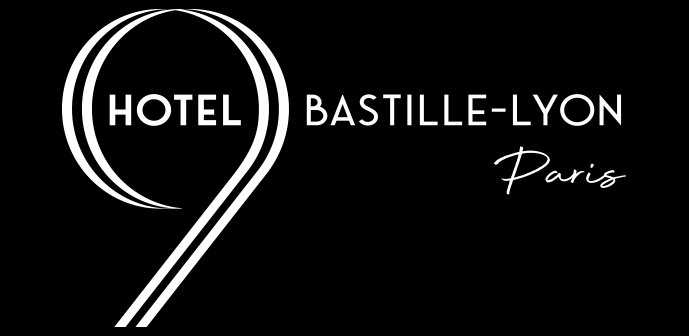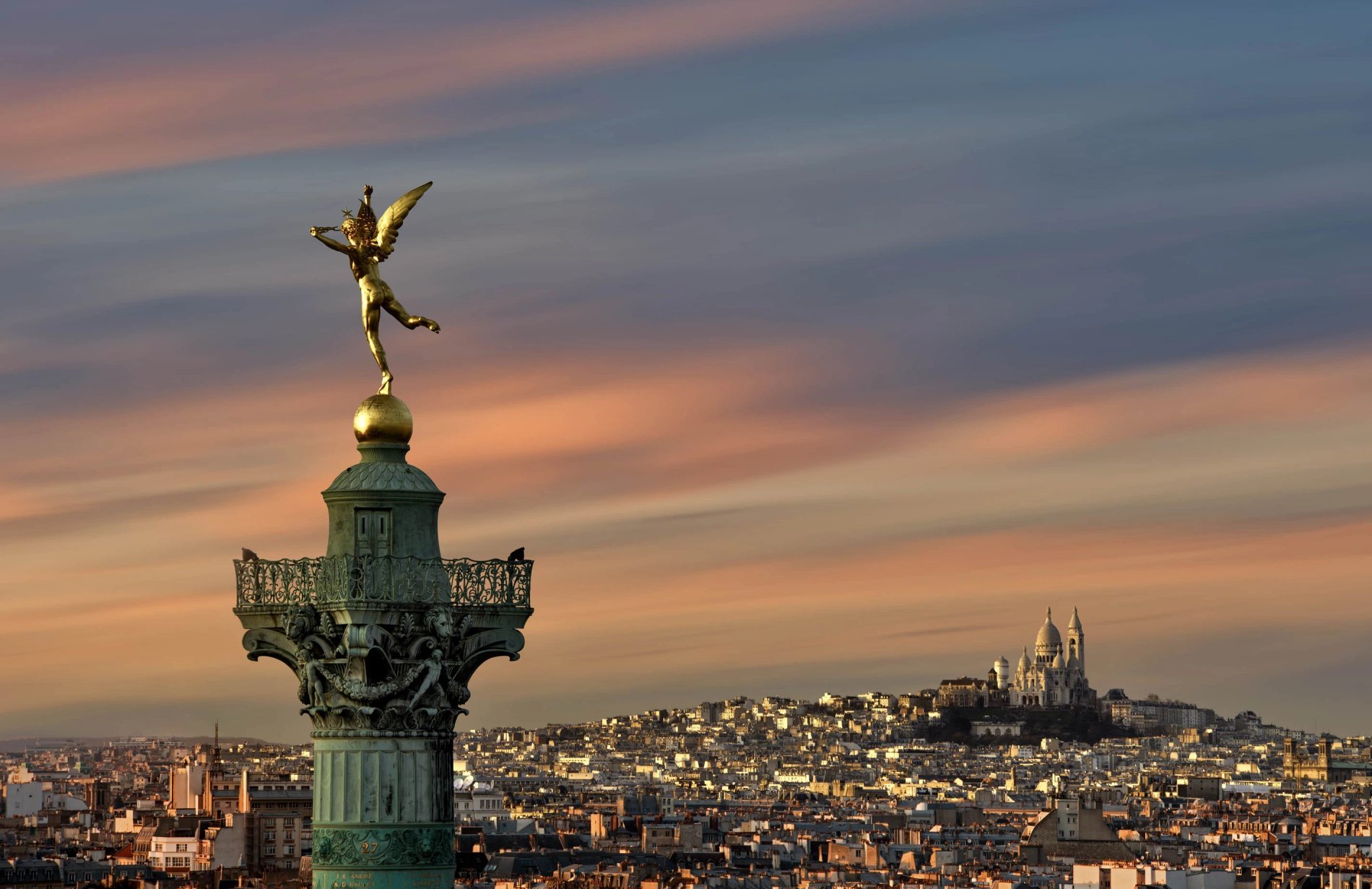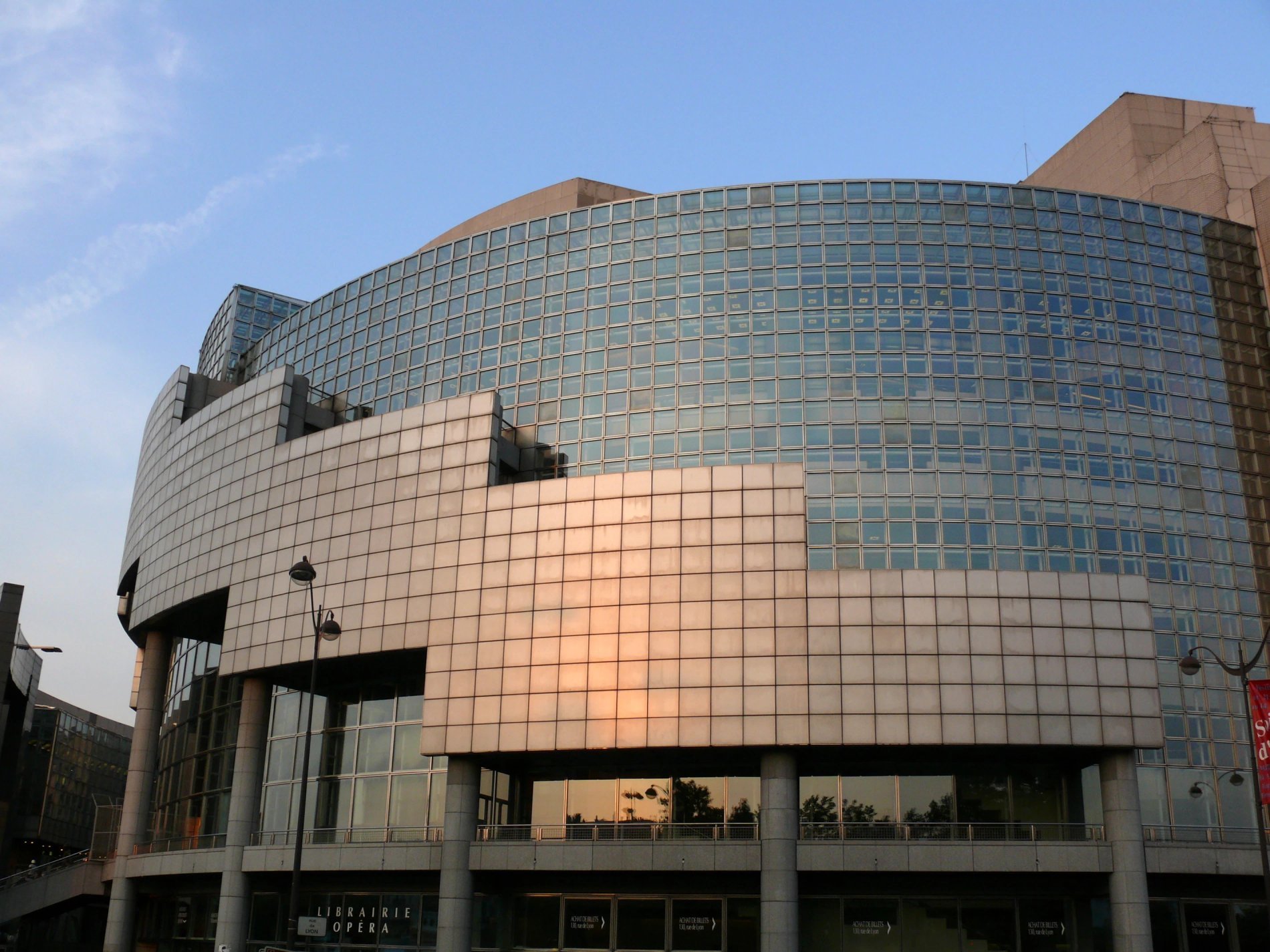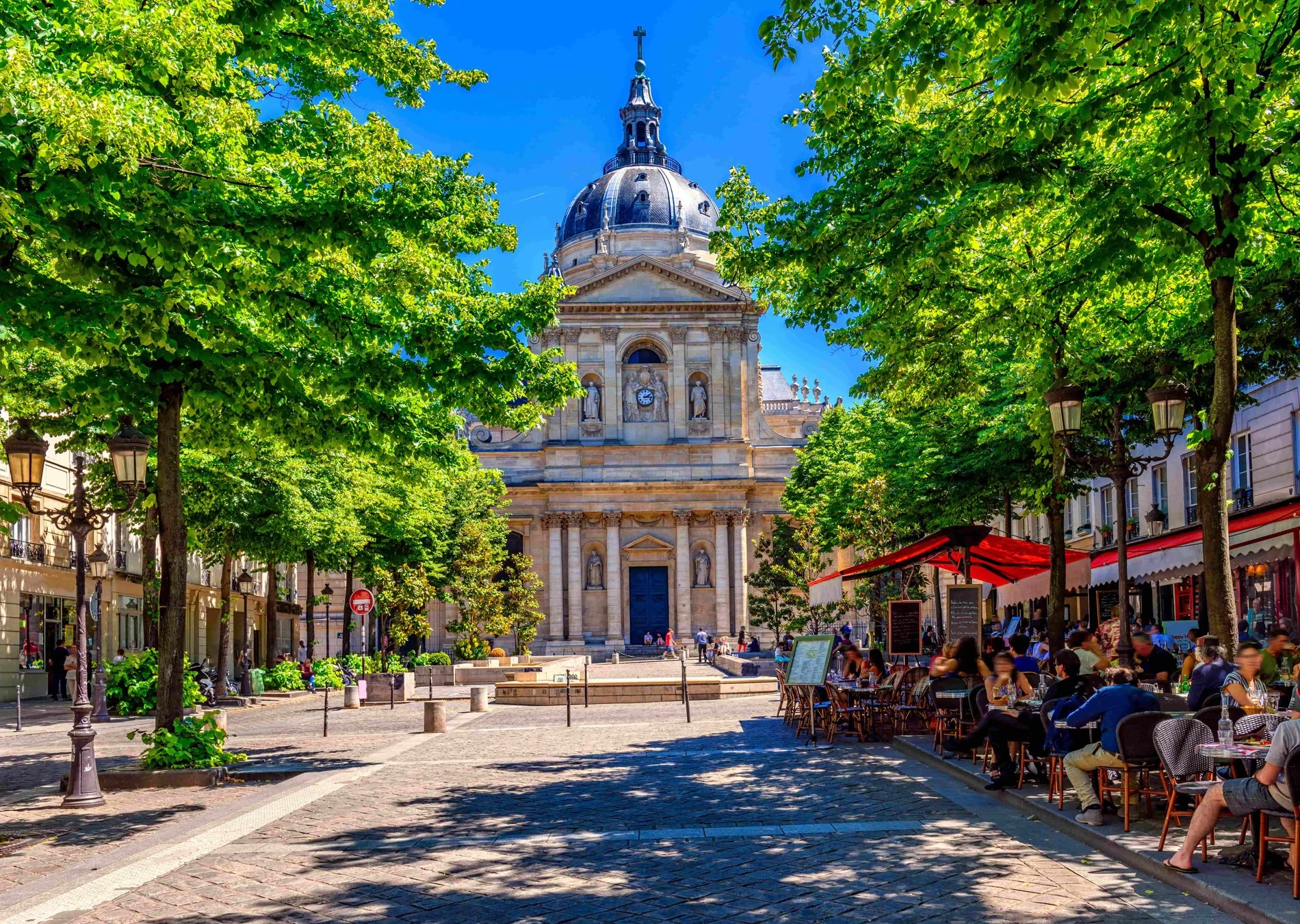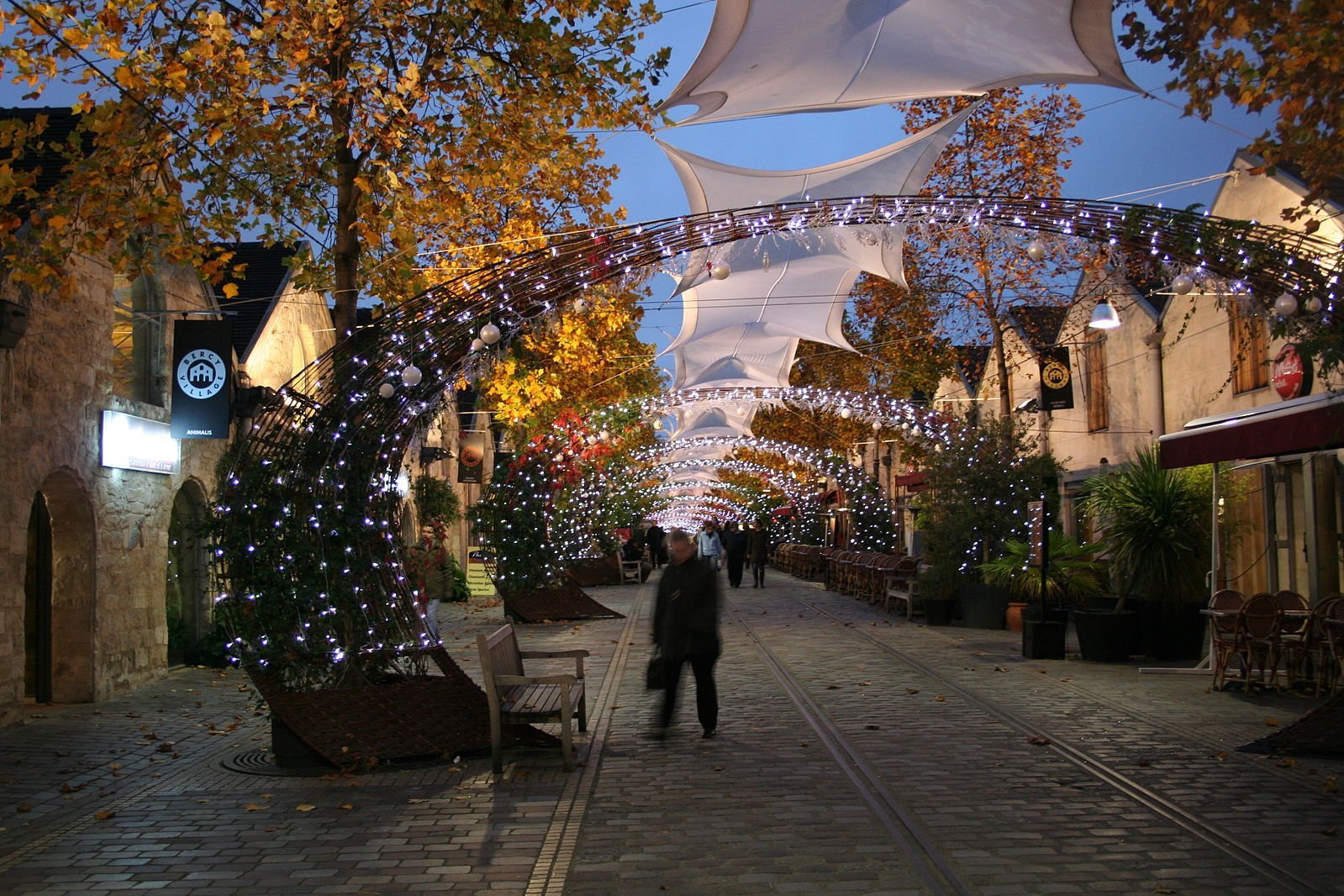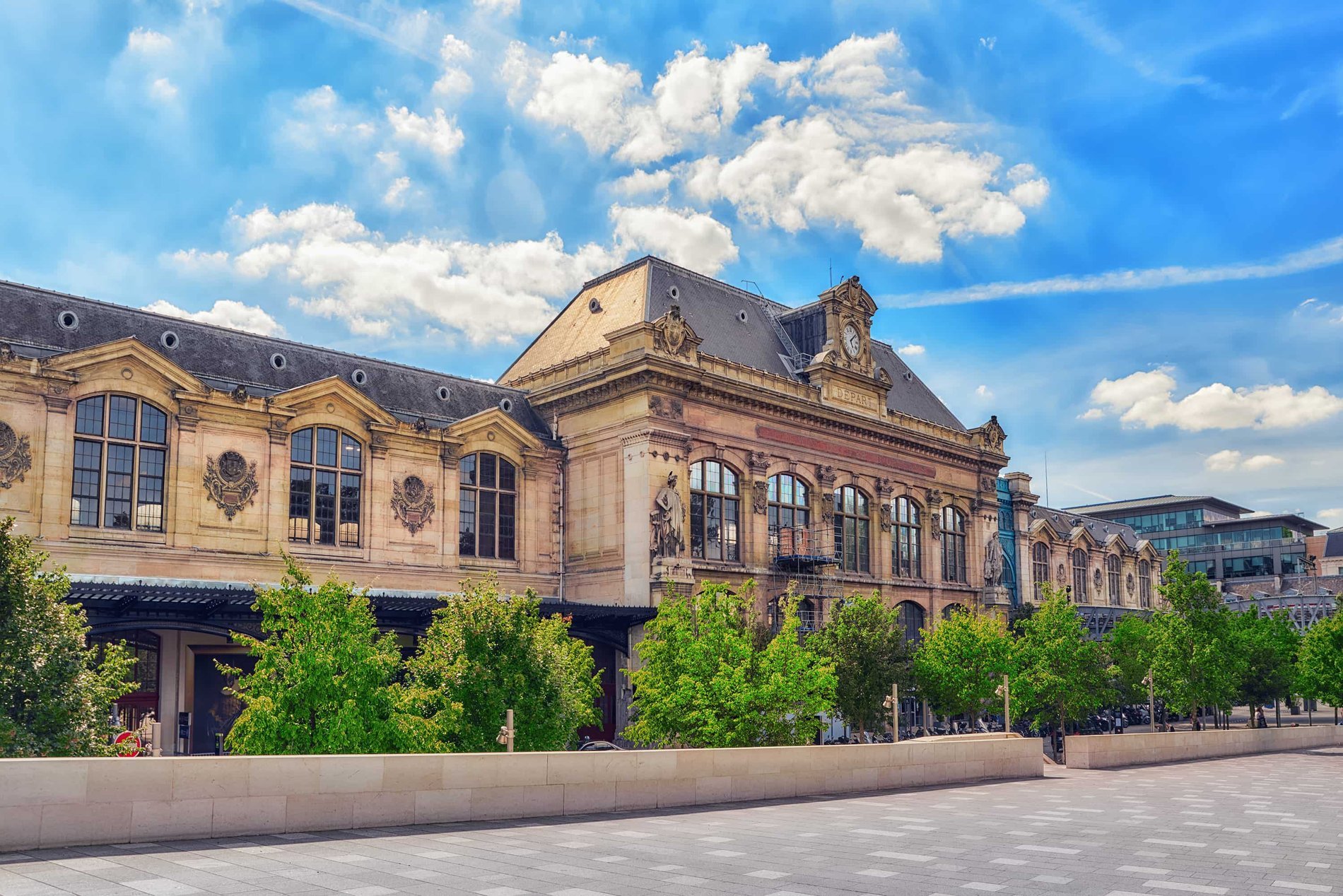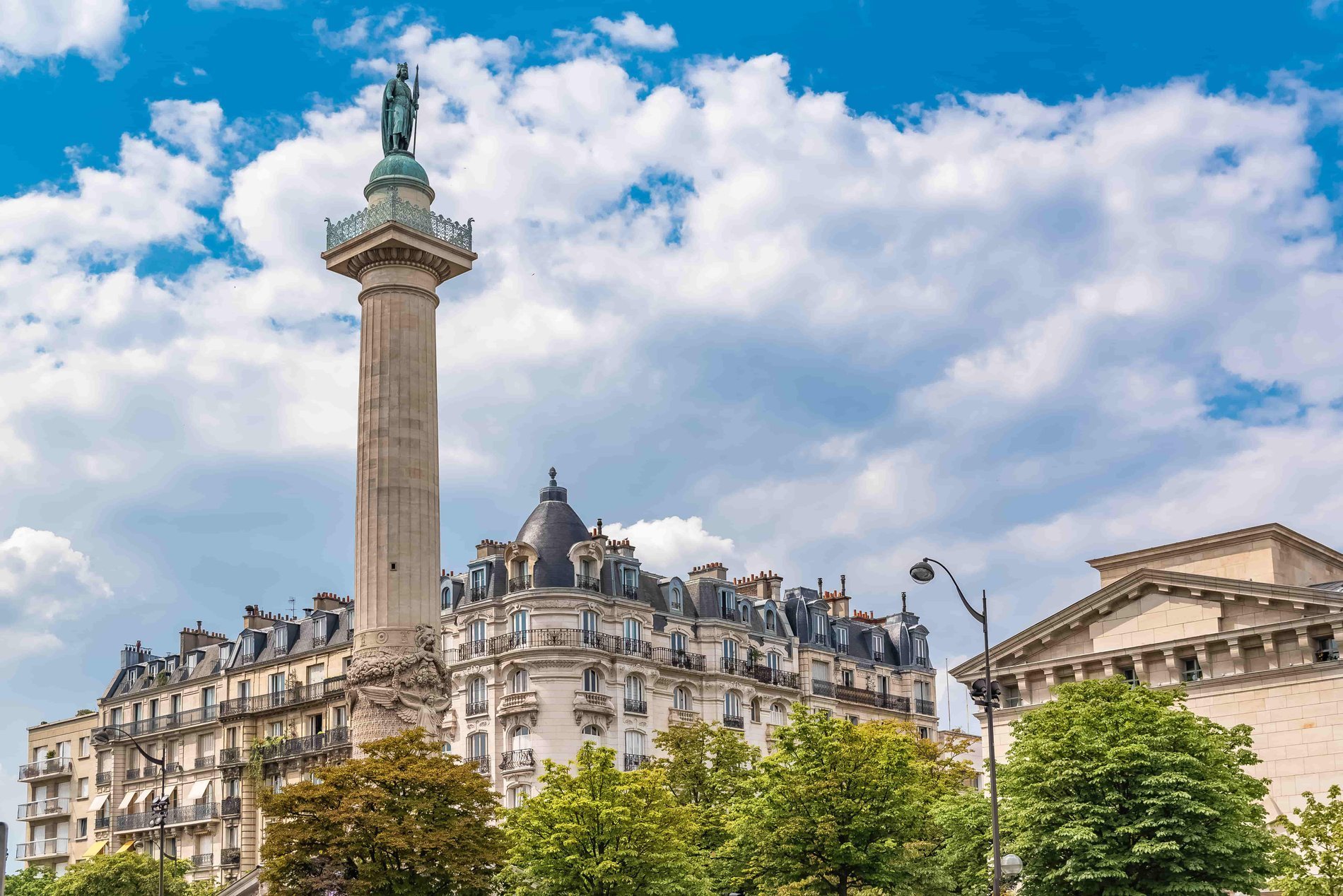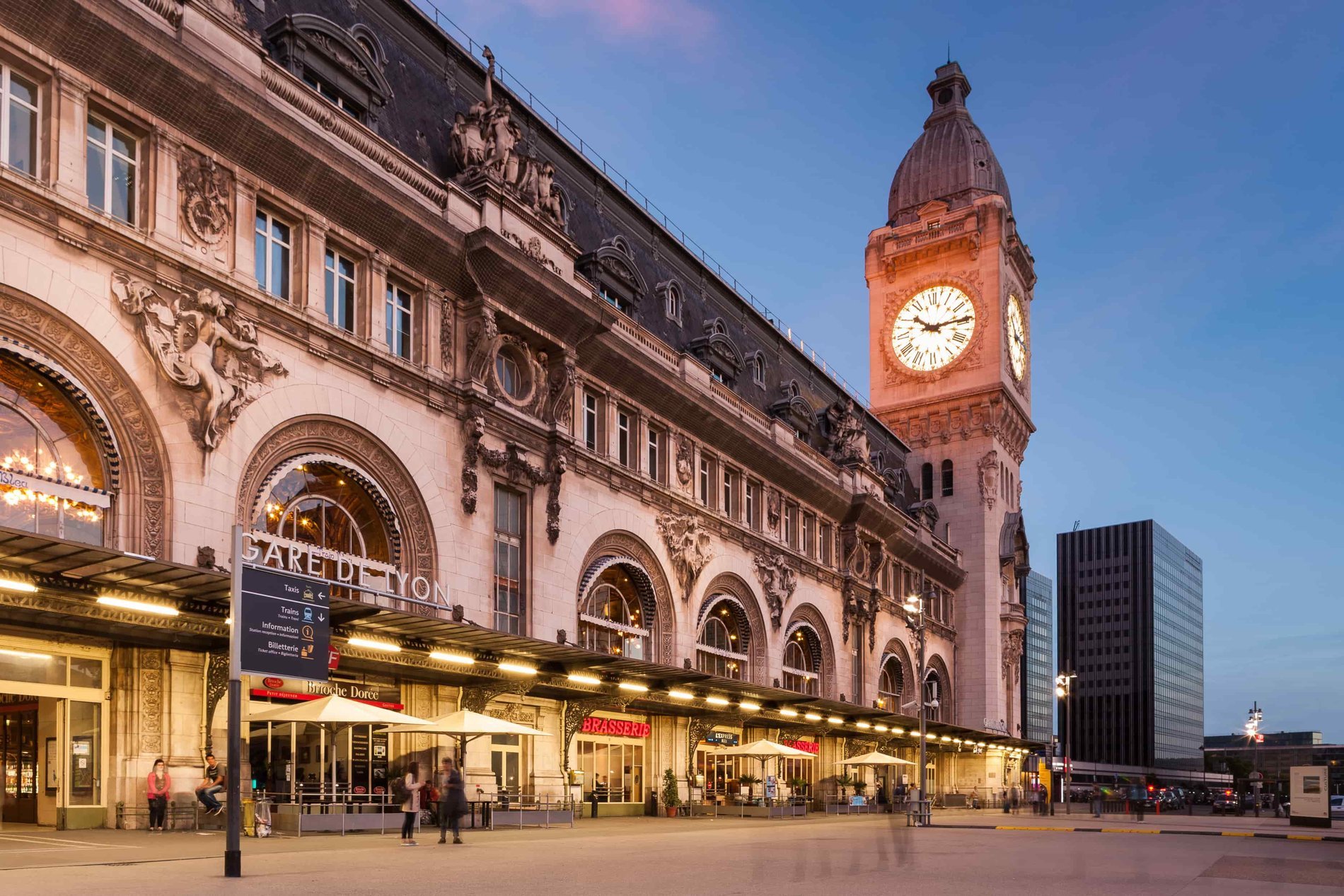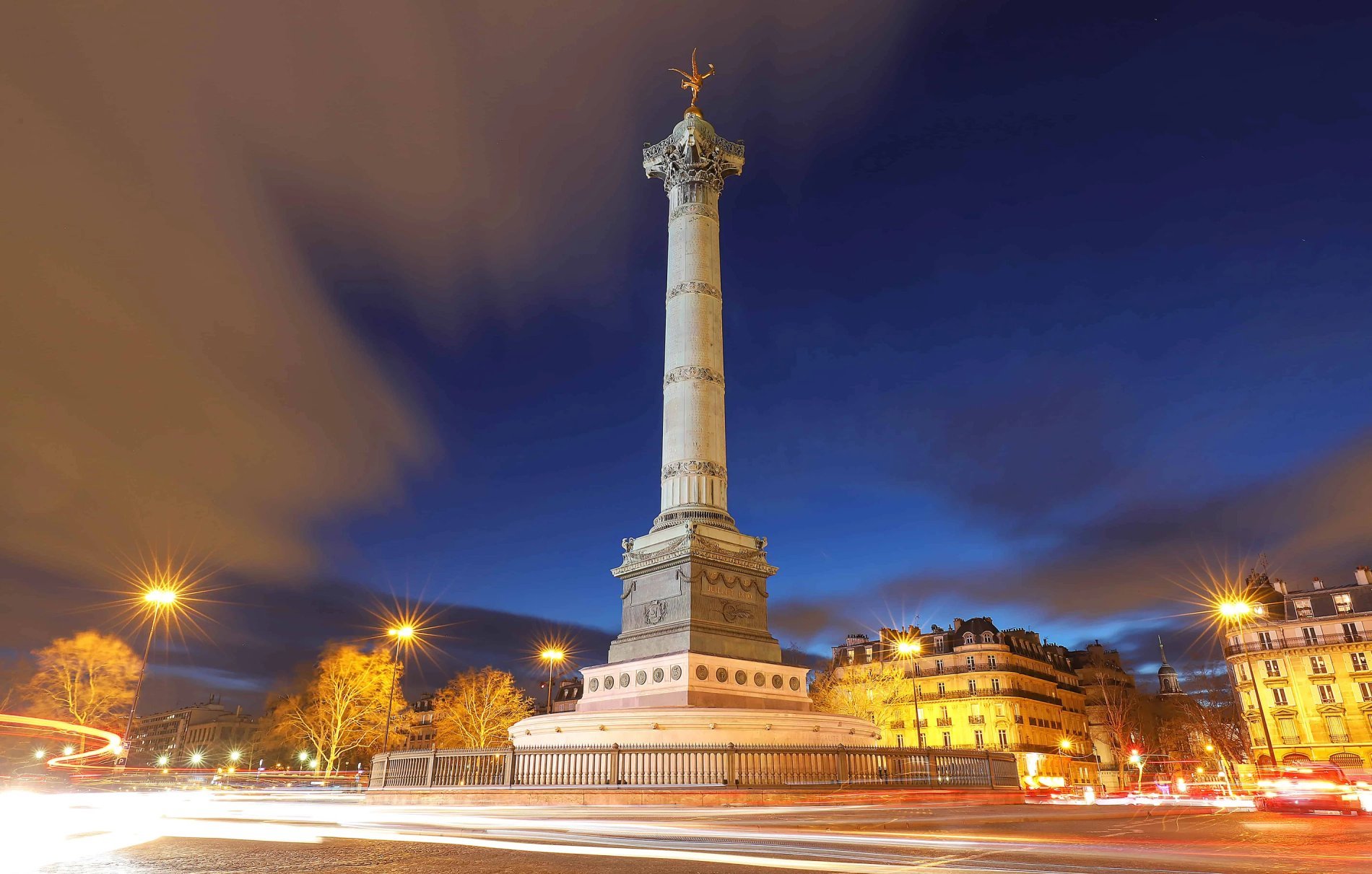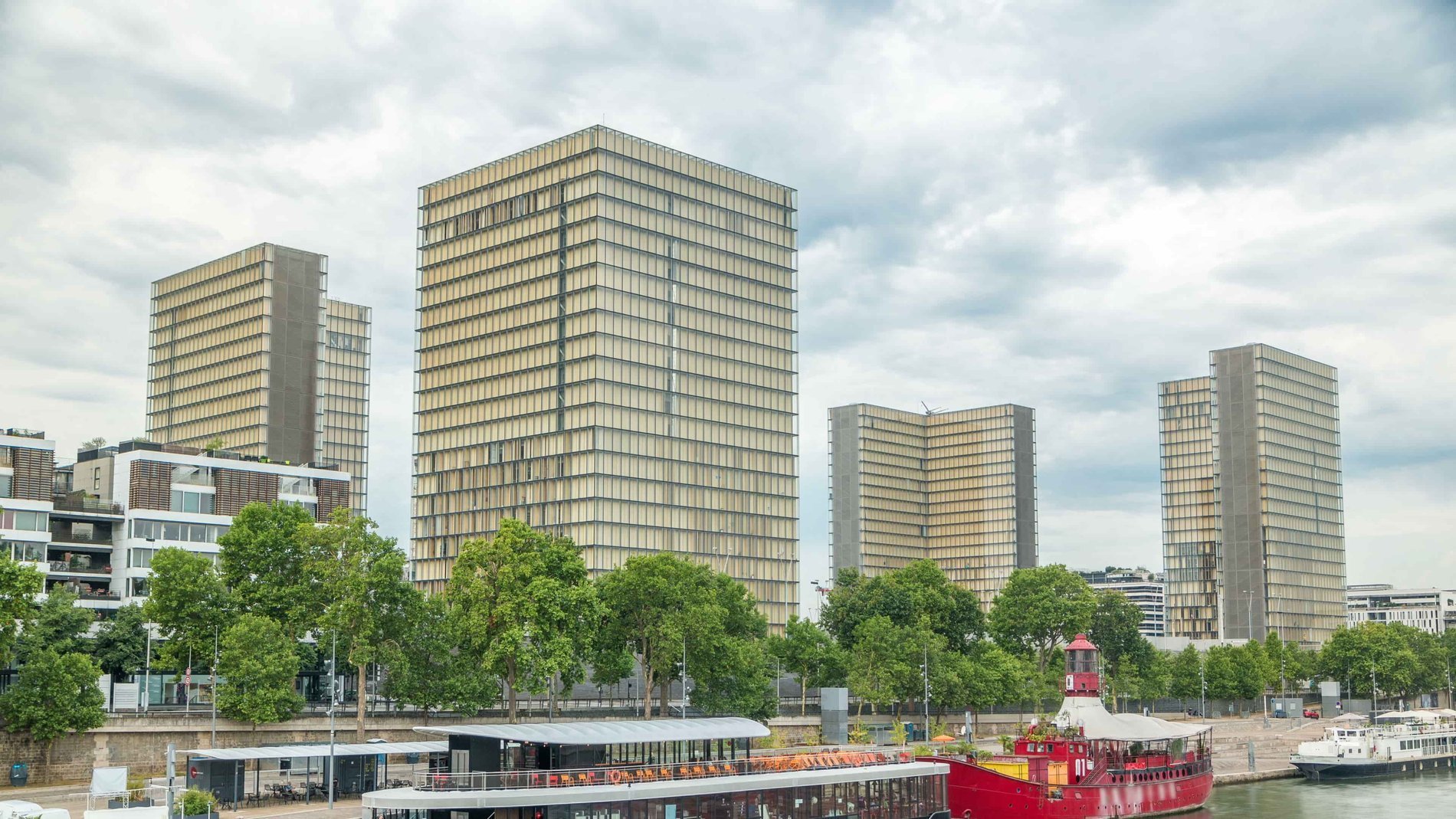Cultural activities and landmarks near 9Hotel Bastille-Lyon
With its ideal location in the heart of the 12th arrondissement of Paris, discover the best restaurants and main attractions in the district around 9Hotel Bastille-Lyon.
Around 9Hotel Batille-Lyon
Cultural activities and landmarks near 9Hotel Bastille-Lyon
With its ideal location in the heart of the 12th arrondissement of Paris, discover the best restaurants and main attractions in the district around 9Hotel Bastille-Lyon.
Opera Bastille
Opera Bastille
Hotel Bastille-Lyon, few steps away from the Opéra Bastille
Hotel Bastille-Lyon, just a few minutes from the Opéra Bastille.
5 minutes walk from the hotel.
Near the Opéra Bastille, a conveniently located hotel.
Constituent, along with the Palais Garnier, the second venue of the Paris National Opera, and was inaugurated in 1989 on the Place de la Bastille. Our Bastille-Lyon hotel is just a few minutes walk from this iconic cultural landmark in Paris, which is one of the largest opera houses of the world.
1989 : the Paris Opéra acquires a modern space.
At the end of the 20th century, François Mitterrand, whose major works for Paris partially reshaped the face of the French capital, decided to build a new opera house. At the instigation of his Minister of Culture Jack Lang, the new President of the Republic decided in 1982 to launch a call for projects for the construction of a new “modern and popular” opera house.
The aim was also to build an opera house in Paris, a city of culture if ever there was one, capable of rivaling the world's greatest halls in terms of both seating capacity and technical capability. Indeed, at the dawn of the 21st century, it's time for more modern machinery, enabling stage directors to imagine shows that have been brought up to date.
Among the 1,700 architectural firms from all over the world who took part in the competition to win the project in 1983, Uruguayan-Canadian architect Carlos Ott came out on top. On November 17, 1983, he won the competition and was entrusted with the weighty and beautiful task of building a new opera house in Paris, a feat not seen since the construction of the Palais Garnier, which took place as part of the great Haussmann works instigated by Napoleon III a century earlier.
A new opera house on the Place de la Bastille.
It's one thing to want a new opera house in Paris, it's quite another to find the space to build it, in a small French capital where architectural harmony is of prime importance and attracts many tourists every year. But François Mitterrand was not one to be impressed by the monumentality of Paris, and he was not afraid to install glass pyramids in the courtyard of the Louvre. Imitating his great predecessor Georges Pompidou, who had the Halles de Paris demolished, François Mitterrand ordered the destruction of the Paris-Bastille railway station between rue de Lyon and rue de Charenton, which had been disused since 1969.
Construction of the Opéra Bastille began in 1984, with the demolition of the old station linking Paris and Vincennes, which had been rendered obsolete by the arrival of the RER A line. Construction work lasted several years, and the new Paris Opera was inaugurated on July 13, 1989, as part of the festivities marking the bicentenary of the French Revolution. However, work was rushed to coincide with the inauguration, so that the first performances could only take place in the spring of 1990, and it soon became apparent that numerous defects required a new phase of work.
Chaotic beginnings for the new opera house on Place de la Bastille.
Despite the technical difficulties involved in building the new Paris Opera House, France can now boast one of the largest opera houses in the world. With a total surface area of 160,000 m², the building designed by architect Carlos Ott is 80 metres high, 30 metres of which are underground.
The main auditorium is 20 metres high, 32 metres deep and 40 metres wide. It seats 2,745, slightly more than the Sydney Opera's Concert Hall, which seats 2,679, but almost a third less than New York's Metropolitan Opera, which seats 3,800.
The orchestra pit at the Opéra Bastille can accommodate 130 musicians, and can be covered to suit the needs of the scenography. The main stage itself is one of the most modern in the world, which is why it required so much work. Measuring 45 meters in height, 30 meters in width and 25 meters in depth, it features nine elevators, enabling the creation of several levels. Installed on three main elevators, it can descend to the lower backstage plateau, which is located on the sixth basement level.
The opera house also boasts two annex halls: a 500-seat amphitheatre beneath the main hall, and a 237-seat studio in the annex building. A new 800-seat auditorium is scheduled to open in 2022-2023.
An opera house in central Paris.
Located at the beginning of the Marais district, the Opéra Bastille is almost as central as the Opéra Garnier, and easily accessible by metro, bike, car or on foot. While the Opera's main entrance is on the Place de la Bastille, facing the Colonne de Juillet, its southern façade extends from the Hôpital des Quinze-Vingts, one of the oldest hospitals in Paris. To the west, the Opéra Bastille is located at 120 rue de Lyon, while its eastern facade adjoins rue de Charenton.
This central location, in a lively Paris where culture is in constant turmoil, makes it a must for Parisian nightlife, just a stone's throw from the Bastille-Lyon hotel
Place de la Sorbonne
Place de la Sorbonne
The Bastille-Lyon hotel, a 30 minutes walk from the Place de la Sorbonne
A Well-Located Hotel Near the Sorbonne
The most prestigious university in Paris, the Sorbonne is deeply linked to the history, student life, and political life of France. Founded during the reign of Saint Louis in the 13th century, it was within its walls that the events of May 1968 first broke out. Largely redesigned under the direction of Cardinal Richelieu, the Sorbonne today features classical facades that make it one of the most iconic landmarks of the Latin Quarter.
The Origins of the Sorbonne: A Faculty of Theology
In 1253, Robert de Sorbon, a master of theology at the Notre-Dame cloister and confessor to King Louis IX, founded the college that would bear his name. Originally from the village of Sorbon in the Ardennes, the institution—initially called the Collège Sorbon, with fluctuating spellings—eventually became known as the Collège de Sorbonne, and later simply La Sorbonne, following the Latin feminine form Sorbona, the clerical language of the time.
The king supported the project for two main reasons. First, the French crown had long been engaged in a power struggle with the papacy. At a time when the Dominican and Franciscan orders (which included scholars like Albert the Great and Thomas Aquinas) were gaining control over theology through their allegiance to the pope, King Louis IX found in Robert de Sorbon a loyal ally capable of counterbalancing their influence.
Second, Saint Louis was determined to help impoverished students. The Collège de Sorbon was thus initially established to host around twenty needy students who received a scholarship and required housing. Several houses on Rue Coupe-Gueule, facing the Hôtel de Cluny and donated by the king, served this purpose.
Officially recognized by the king in 1257, the Sorbonne functioned as a religious community where theology remained the primary discipline, but unlike monasteries, it welcomed secular priests and poor students.
A Classical Landmark in the Latin Quarter
Perched on the Montagne Sainte-Geneviève, today’s Sorbonne owes much to the architect Jacques Lemercier. After receiving a few houses from the king, Robert de Sorbon gradually acquired most of Rue de la Sorbonne by 1260, expanding the institution across what was then a patchwork of barns and houses surrounding a garden.
To impose a devout and austere lifestyle, Robert de Sorbon refrained from any grand construction. By the early 17th century, little had changed architecturally until Cardinal Richelieu, himself a former student (1606–1607), undertook a complete renovation after becoming principal in 1622.
This was the age of grand projects. With France asserting its cultural dominance under the classical era, Richelieu sought to turn the Sorbonne into not only a center of knowledge in Europe but also a building reflecting the grandeur of the nation. He commissioned Jacques Lemercier to completely redesign the Sorbonne.
The chapel was elevated, and its dome was painted by Philippe de Champaigne. After Richelieu’s death, he was entombed there in a monument sculpted by François Girardon. Construction began in May 1635 and was nearly complete at Richelieu’s death, except for the chapel, now regarded as a masterpiece of Parisian classical architecture.
The college doubled in size and inherited the cardinal's library. Richelieu, who also founded the Académie Française, significantly shaped the institution.
The Sorbonne After the French Revolution
During the French Revolution, the Sorbonne was closed to students and repurposed as a Temple of Reason. In 1806, Napoleon Bonaparte founded the Imperial University, but the Sorbonne was assigned to artists. In 1821, the faculties of science, literature, and theology returned, and the Sorbonne also became the seat of the Rector of the Paris Academy.
Under the Restoration, the cardinal’s great-nephew, Duke of Richelieu, then Prime Minister to King Louis XVIII, built a 1,200-seat amphitheater to honor the cardinal and further elevate the university's prestige.
Despite renovations, the building could no longer accommodate the growing student population. Under the Second Empire, architect Léon Vaudoyer proposed a new academic palace, but the plan was abandoned. It was eventually Henri-Paul Nénot, a student of Charles Garnier (architect of the Paris Opera), who won the project for the new Sorbonne.
His design, a perfect example of Haussmannian classicism, combined simplicity and grandeur. All buildings except the chapel were demolished between 1884 and 1894. The northern wing was inaugurated in 1889 by President Sadi Carnot, celebrating the Revolution’s centenary, and the full project was completed by 1901.
The Modern Sorbonne
The new Sorbonne building designed by Paul Nénot includes several structures across the steep northwest slope of the Montagne Sainte-Geneviève, bordered by Rue Saint-Jacques, Rue Cujas, Rue des Écoles, and Rue de la Sorbonne.
The chapel, now a listed historic monument, was preserved. To the north, the Rue des Écoles wing houses the university rectorate and administration. To the south lies the Faculty of Sciences, while the central courtyard is surrounded by lecture halls, large amphitheaters, and a central library—now home to the Faculty of Letters.
Over time, plans changed: areas initially intended for theology were allocated to the École des Chartes. In 1896, the faculties of law, letters, medicine, and science were merged into a single legal entity: the University of Paris, with the rector of the Paris Academy serving as its president.
The Sorbonne in Modern History
On May 1, 1906, Marie Curie gave the Sorbonne's first-ever lecture by a woman, replacing her late husband Pierre Curie. When she delivered her inaugural lecture on November 5, journalists, artists, and the Paris elite crowded the physics lecture hall to witness a landmark feminist moment.
In May 1968, although the student unrest began at the Nanterre campus, events escalated when the university president called in police to evict students from the Sorbonne courtyard. This sparked weeks of protests, culminating in the general strike of May 13, and the Sorbonne was occupied.
A university reform followed, dividing the University of Paris into thirteen new institutions. Since then, first-year students—often seen as more rebellious—have been sent to campuses like Censier or Clignancourt.
In March 2006, protests against the First Employment Contract (CPE) law led to the Sorbonne being occupied from March 8–11 before police cleared it. Similar protests attempted to block the university in 2009 and again in 2018, but were quickly shut down.
The Sorbonne: A Symbol of Higher Learning in the Latin Quarter
From royal to republican power, the Sorbonne has remained France’s most renowned university, still one of the most prestigious today. While currently closed to the public due to Vigipirate security measures, guided tours can be booked, and the site is accessible during European Heritage Days.
Located just steps from the Panthéon, which crowns the Montagne Sainte-Geneviève, the Sorbonne sits in the heart of the Latin Quarter—Paris's legendary student district, alive year-round with youth, knowledge, and culture.
From 9Hotel Bastille-Lyon, the Sorbonne is easily reachable. Walk across the Pont d’Austerlitz and through the Jardin des Plantes, or cross the Pont de Sully at the eastern tip of Île Saint-Louis. Whether on foot, by bike, car, metro, or bus, the journey is a scenic one. Many prefer walking above ground to enjoy one of the most beautiful parts of Paris.
The name Sorbonne continues to resonate because this university has long been a center of intellectual and political debate, and it still shines today—whether because of, or despite, the controversies it sparks.
Cour Saint-Émilion
Cour Saint-Émilion
9Hotel Bastille-Lyon, just minutes away from Cour Saint-Émilion
9Hotel Bastille-Lyon Near Cour Saint-Emilion in Paris
Just a 10-minute walk from the hotel
A Well-Located Hotel Near Cour Saint-Emilion
Located along the Seine, downstream from the 9Hotel Bastille-Lyon, Cour Saint-Emilion is an iconic spot in the Bercy neighborhood. Once part of the former wine warehouses in the village of Bercy, it now houses a shopping center, but also numerous wine bars and shops where Parisians gather after work or on sunny days to enjoy a glass of wine and a platter of charcuterie or cheese.
Cour Saint-Emilion: A Place for Parisian Strolling
Bercy’s history as the world’s largest wine market is now just a memory, with only a double row of wine cellars remaining, where cafés, wine bars, and restaurants have set up their terraces along a cobblestone street. As soon as the sun comes out, Parisians, wanderers, and tourists flock to the tables and benches to share a drink or a good meal with friends.
This quiet haven at the heart of Paris, just steps from the Ministry of Finance and the largest sports and concert venue in Paris, the former Palais Omnisport de Paris-Bercy now known as AccorHotels Arena, attracts a diverse crowd. On weekdays, office workers gather at lunchtime for a working lunch or with colleagues for an “afterwork” drink. On weekends, families, strollers, and tourists take over.
True to its tradition, this small neighborhood on the banks of the Seine offers both wine and food, and hosts many events throughout the year. The arrival of Beaujolais Nouveau is notably celebrated every year.
The Former Wine Warehouses of Bercy
If you pay a little attention as you walk through Cour Saint-Emilion, you’ll notice that you’re walking on cobblestones with railway tracks still visible between them. However, you won’t see any trains or trams passing through this square. These are remnants of a glorious past, when Bercy Village was a hub of activity in Paris, either selling wine or driving up prices.
In the 19th century, the wine merchants were so influential that they didn’t hesitate to call upon Napoleon III to demand the enforcement of laws throughout France. The merchants felt that wine producers were cheating them by using different units of measurement from one region to another.
Wine sales were highly profitable at a time when Paris’s consumption was rising steadily. For instance, wine consumption in the French capital increased from one million hectoliters in 1800 to 3.55 million hectoliters in 1865. The largest part of this wine was stored in Bercy before being sold throughout Paris after the merchants blended the wines.
The Rich History of Cour Saint-Emilion
To understand the history of this square, named after a famous wine from the Bordeaux region, we must go back in time. The name Bercy (also written as Bercix) dates back to the 12th century, when it was a commune outside of Paris.
In the early 18th century, the wine trade began to develop in Bercy, encouraged by a Burgundy winemaker during the reign of King Louis XIV. The Sun King allowed the tax on wines distributed in Bercy to be lifted. At the time, a customs barrier was set up at Quai de la Rapée. This indirect tax, levied on the value of goods, allowed for the control of what entered and left the city, helping to limit smuggling. Since wine was considered a non-essential product, it was usually taxed when it entered Paris. However, by storing it outside the city, merchants were able to avoid these taxes when importing wine from French provinces.
In 1810, Baron Louis, then Minister of Finance, bought large plots of land in Bercy, where the warehouses were located. After refurbishing the area through a company he founded, he developed the wine trade, turning it into one of the world’s largest wine storage facilities.
The Wine Trade in Cour Saint-Emilion
Wine barrels from the Burgundy, Bordeaux, Languedoc, Beaujolais, and Rhône regions arrived in Paris by boat on the Seine. Before entering the capital, these barrels were unloaded and stored in the wine cellars of Bercy.
However, as wine consumption continued to rise under the First Empire, a new wine market was built. Despite the project spanning three decades, the market’s capacity was quickly surpassed. In the meantime, railways were laid down to transport the wine barrels more quickly than by boat. It is these rails that can still be seen in Cour Saint-Emilion, dating back to the golden age of rail travel.
In 1869, under Napoleon III, the authorities decided to expand and renovate the Bercy warehouses, which would soon cover an area of 42 hectares. The Petit Bercy and Grand Bercy were built by the famous architect Viollet-le-Duc. From then on, wine barrels passing through Paris were stored in Bercy. The merchants did more than just bottle the wine; they also blended it in their cellars. These blended wines became their fortune until the 1960s. However, as the quality of these wines often became questionable and customers began to demand higher quality, this marked the beginning of the end for them, while estate-bottled wines gained prestige and became the choice of refined palates.
The Major Developments in the Bercy District
It was during the era of grand construction projects under François Mitterrand that the former village of Bercy was radically transformed. In the early 1980s, the Palais Omnisport de Paris-Bercy, now known as the Accor Arena, was built. This sports and concert venue has a capacity of over 20,000 seats.
A little further along the Seine River, between the 9Hotel Bastille-Lyon and Cour Saint-Emilion, the Ministry of Finance and the Economy was built in 1990. The restructuring of the Bercy district and the decline of the merchants’ trade marked the end of the wine warehouses. Today, only the Parc de Bercy, created on the former site of the warehouses, preserves some of the old pavilions, as well as Cour Saint-Emilion, which also gives its name to the nearby metro station.
Some of the cellars were listed on the Supplementary Inventory of Historical Monuments in 1985. This includes the Lheureux cellars, now home to the Pavillons de Bercy, a cultural venue dedicated to the heritage of performing arts and fairground arts.
The architecture of these warehouses also inspired the design of Bercy Village, a shopping and entertainment area opened in 2000. Around the Place des Vins-de-France, a business district was developed, and several streets and squares in the neighborhood still bear names that evoke this prestigious past when Bercy supplied all of Paris with wine. A tribute is paid to Pierre Le Roy de Boiseaumarié, the creator of Appellations d'Origine Contrôlée (AOC), which helped improve the quality of wines and increase respect for vineyards and their care.
Now that you know all of this, you won’t be surprised to find so many Parisians seated around a glass of wine in one of the wine bars of Cour Saint-Emilion. When you join them, after strolling along the Seine, you’ll remember that in this very spot, not long ago, stood one of the world’s largest wine storage facilities. Perhaps, if you listen carefully, you’ll hear the merchants calling out to sell their precious merchandise to the highest bidder, or maybe the metallic wheels of a train arriving at the station, loaded with barrels full to the brim.
9Hotel Bastille-Lyon near Gare d’Austerlitz in Paris
9Hotel Bastille-Lyon near Gare d’Austerlitz in Paris
Just a 10-minute walk from the hotel
A Hotel Just Minutes from Gare d’Austerlitz
Located just a few minutes on foot from Gare d’Austerlitz, one of the six major railway termini in Paris, our hotel enjoys a prime location. Thanks to recent renovations, the station has become one of the capital’s most important hubs. From here, visitors can easily reach the Latin Quarter by walking through the Jardin des Plantes or taking Boulevard Saint-Marcel, which runs past Pitié-Salpêtrière, the largest hospital in Paris.
A Hotel Near Gare d’Austerlitz in Central Paris
Just ten minutes on foot via Pont d’Austerlitz, or a few minutes by car, the hotel is located less than 2 km from the station. Gare d’Austerlitz is served by two metro lines, the RER, which offers direct access to the Champ de Mars, the Eiffel Tower, and Versailles, as well as numerous intercity lines heading to central France and the Loire Valley castles.
Originally named Gare d’Orléans, the station sits on the Left Bank of the Seine, next to Pitié-Salpêtrière hospital and facing the Jardin des Plantes. Built in 1840, the station has undergone several renovations. Its vast metal hall, stretching 280 meters, evokes the remarkable architecture of the Eiffel Tower, and is the second-largest in France after Bordeaux-Saint-Jean station.
Gare d’Austerlitz was also the first Parisian train station to feature an underground line for suburban trains, and like Gare de Lyon, it has been officially listed as a Historic Monument. It takes its name from Napoleon Bonaparte’s most famous military victory in 1805, though the former station restaurant “Le Grenadier,” named in tribute to the battle, was demolished in 2012.
A Station Close to the City Center
Stepping out of Gare d’Austerlitz, travelers find themselves directly on the Left Bank of the Seine, facing the Jardin des Plantes and Boulevard de l’Hôpital, which runs alongside Pitié-Salpêtrière, the largest hospital complex in Paris.
It was Louis XIV who tasked architect Libéral Bruant with building a hospital on the site of a former gunpowder factory—hence the name “Salpêtrière”, from salpeter or saltpeter, used in making gunpowder. Originally created to house beggars, and also used as a prison, La Salpêtrière became, on the eve of the French Revolution, the largest hospice in the world, capable of sheltering 10,000 people. Today, it is still a leading public university hospital, considered a city within the city, and home to world-renowned medical departments.
From Gare d’Austerlitz to Rue Mouffetard
To reach the legendary Rue Mouffetard, one of the oldest streets in Paris—dating back to the late Roman Empire, in the 3rd century AD—you can walk or take a bus or car up Boulevard de l’Hôpital, then continue via Boulevard Saint-Marcel, or stroll through the Jardin des Plantes, the largest botanical garden in Paris.
The Jardin des Plantes is home to the National Museum of Natural History, including the famous Gallery of Evolution, known for its impressive collection of dinosaur skeletons. As early as the 16th century, herbalism classes were taught here by Nicolas Houël, the king’s apothecary. In 1626, a royal decree established the Royal Garden of Medicinal Plants. In the 18th century, Buffon served as its director, and it was during the French Revolution that it was renamed Jardin des Plantes. The garden is traditionally open from sunrise to sunset.
In earlier times, the Bièvre River—now flowing underground—ran south of the garden. Five large metal-frame greenhouses line the formal French garden path, showcasing tropical and desert flora.
The Ménagerie, or zoo, created in 1793 by Bernardin de Saint-Pierre, is the second-oldest zoo in the world. It is still home to over 1,000 animals, including rare species and a vivarium.
The Latin Quarter and Montagne Sainte-Geneviève
Leaving the Jardin des Plantes via Rue Geoffroy Saint-Hilaire, you’ll find yourself facing the Great Mosque of Paris, designed in Hispano-Moorish style, inspired by the Alhambra of Granada. Here, you can enjoy mint tea with oriental pastries, dine in the restaurant, visit the hammam, or explore the beautifully decorated prayer hall.
Just a few hundred meters away are the Arènes de Lutèce, classified as a Historic Monument. Open daily and free to visit, they are, along with the Cluny Baths, the last visible remains of Gallo-Roman Paris.
From there, you can begin your ascent of the Montagne Sainte-Geneviève, leading to the Panthéon, in the heart of the Latin Quarter. It is surrounded by iconic landmarks: Lycée Henri IV, Saint-Étienne-du-Mont Church, the former École Polytechnique, the Sainte-Geneviève Library, the Sorbonne, and the Luxembourg Gardens.
Before heading back to the Seine, stroll along Boulevard Saint-Michel, or take a peaceful detour through the Luxembourg Gardens, perhaps pausing by the Medici Fountain, beneath the windows of the French Senate.
9Hotel Bastille-Lyon, Just Steps from Place de la Nation in Paris
9Hotel Bastille-Lyon, Just Steps from Place de la Nation in Paris
A 20-minute walk from the hotel
A Well-Located Hotel Near Place de la Nation
Just a short walk from Place de la Nation, a square steeped in history, 9Hotel Bastille-Lyon enjoys a prime location. Formerly known as Place du Trône, it is one of the most important squares in Paris and lies just a few hundred meters from Place de la Bastille. Redesigned multiple times over the centuries, it has recently been largely returned to pedestrians and cyclists thanks to the urban policies of Paris mayor Anne Hidalgo, creating a more social and green urban space.
From Place du Trône to Place de la Nation
Situated along the road connecting Paris to Vincennes, the square was originally named Place du Trône ("Throne Square") in honor of the throne erected on August 26, 1660, to welcome King Louis XIV and his young bride Marie-Thérèse of Austria, who made a grand entrance upon returning from their royal wedding in Saint-Jean-de-Luz.
At that time, the area was nothing more than meadows and farmlands on the outskirts of Paris, dotted with farms, convents, and vineyards. The Fermiers Généraux Wall, which served as the city’s tax boundary, had recently been extended beyond this point, incorporating the current Place de la Nation—then a vacant lot—into the city.
On August 10, 1792, during the French Revolution, the square was renamed Place du Trône-Renversé ("Toppled Throne Square"). It would soon become a gruesome site, as a guillotine was erected there on June 13, 1794, claiming more than 1,000 lives in just a month and a half. The victims’ remains were buried in mass graves in the nearby Picpus Cemetery.
It wasn’t until July 14, 1880, during the celebration of France’s first national holiday, that the square officially received the name Place de la Nation.
A Square That Has Evolved Over Time
Now located at the border of Paris’s 11th and 12th arrondissements, Place de la Nation has seen many transformations over the centuries. Originally outside the city walls, it became part of Paris in the 17th century.
In 1669, to commemorate the royal procession to Place du Trône, Colbert, Louis XIV’s minister, commissioned a triumphal arch, awarding the project to Claude Perrault. The design included a massive equestrian statue of the king atop a 50-meter-high monument with three openings and Corinthian columns. Construction began in 1670, but was halted, and the unfinished structure was eventually demolished in 1716.
Later, in 1787, architect and urban planner Claude-Nicolas Ledoux erected two columns flanking the city’s tax gate and the entrance to the Cours de Vincennes. Statues of Philip Augustus and Saint Louis were added atop the columns in 1845. Napoleon III also intended to build a triumphal arch on the square, but his plans never came to fruition.
Instead, the Triumph of the Republic monument now stands at the center of the square. Commissioned in 1879 by the city of Paris from sculptor Aimé-Jules Dalou, the statue was inaugurated in plaster in 1889 to commemorate the centenary of the French Revolution, and in bronze in 1899.
The monument depicts the Republic standing tall on a chariot drawn by two lions, surrounded by allegorical figures including the Genius of Liberty, a blacksmith representing Labor, Justice, and Abundance, who sows the seeds of prosperity. Children surround the ensemble, symbolizing hope and the future.
A Contemporary Urban Landmark
During Anne Hidalgo’s term as mayor, Paris undertook the “reinvention” of seven major public squares, including Place de la Nation. Previously described as “more of a roundabout than a true square,” the area has been transformed into a pedestrian-friendly and welcoming space, where green areas have been doubled.
The square’s layout has been rebalanced in favor of pedestrians and cyclists, at the expense of car traffic. The central island is now broader, planted with grass and over fifty new trees, offering shade and a breath of fresh air to passersby—bringing a hint of the countryside to the heart of Paris.
As a historically and geographically central point of the city, Place de la Nation is a major hub from which several key avenues radiate, including Avenue du Trône, Boulevard Diderot, Boulevard Voltaire, and Avenue du Faubourg Saint-Antoine. It is served by four metro lines, one RER line, and numerous bus lines.
From a Throne to a Fairground
The Foire du Trône, France’s oldest fair and Europe’s largest funfair, takes its name from the square’s former title. First held in 957 during Holy Week at Saint-Antoine Abbey, which once occupied part of today’s Place de la Nation, the fair was moved after the abbey’s destruction during the French Revolution.
Since 1965, the Foire du Trône has taken place on the Pelouse de Reuilly, not far from Place de la Nation, keeping alive the memory of the square’s historic name.
From Place de la Nation, you are also within close reach of the famous Père Lachaise Cemetery, the Bois de Vincennes, and its remarkable zoological park. There is so much to explore for those who enjoy wandering the city and discovering the richness and diversity of Parisian life.
Gare de Lyon
Gare de Lyon
9Hotel Bastille-Lyon, just 5 minutes on foot from Gare de Lyon
Located in the heart of Paris, our hotel is close to both the city’s historical districts and Gare de Lyon, from which trains depart to Lyon, the Alps, Switzerland, Italy, Provence, and the French Riviera. Perfectly situated just steps from the Seine River and the famous Coulée verte René-Dumont, the hotel is also near Place de la Bastille and the Quinze-Vingts neighborhood.
In the 12th Arrondissement: A Peaceful District Near the Center
The 12th arrondissement offers the best of both worlds: quiet residential areas and close proximity to central Paris. 9Hotel Bastille-Lyon is ideally located halfway between Place des Vosges—the city’s oldest square, famed for its architecture—and the Jardin de Reuilly, at the foot of the district’s town hall.
Just one minute from the hotel is Avenue Ledru-Rollin, which leads directly to the Seine at Quai de la Rapée and Pont d’Austerlitz. Cross the bridge and you’ll reach the Jardin des Plantes, marking the gateway to the Latin Quarter. From the bridge, enjoy stunning views of Île Saint-Louis and Notre-Dame Cathedral to the northwest, as well as the Cité de la Mode et du Design and the Ministry of Finance to the southeast.
Alternatively, head toward the Arsenal marina, right by Place de la Bastille, and discover the lively Marais district—one of Paris’s most vibrant neighborhoods—on the Right Bank, which is prone to flooding during the Seine’s high waters.
The Coulée Verte René-Dumont
South of Place de la Bastille, near the hotel, begins the Coulée Verte René-Dumont. Starting at the Viaduc des Arts, this 5-kilometer pedestrian walkway follows the old Vincennes railway line, stretching all the way to the Paris ring road. It winds through the Jardin de Reuilly and Square Charles Péguy, both landscaped at the same time, offering an aerial stroll among lush vegetation, footbridges, and scenic paths.
The original railway connected Gare de la Bastille, formerly located where the Opéra Bastille now stands, to the eastern suburbs. Built in 1859, the line was decommissioned 110 years later. Architects Philippe Mathieux and landscape designer Jacques Vergely then transformed it into a green urban promenade.
It’s a unique pathway in the heart of Paris—elevated in parts and nestled in greenery—where one can wander above or below, especially through Square Charles Péguy, known for its beautiful magnolia trees that bloom as early as April, delighting both the eyes and the senses.
A Hotel Near Paris Gare de Lyon
Choosing a hotel near Gare de Lyon is a smart option for visiting Paris or enjoying a weekend getaway to southern France—a region full of stunning landscapes, rich history, and the sweet art of living.
Just 5 minutes on foot, Bastille metro station connects you to three metro lines, offering access to all corners of the city. Gare de Lyon also provides quick connections to the RER A and RER D, and to metro lines 1 and 14.
Inside the station, the legendary Train Bleu restaurant offers a feast for both the eyes and the palate. A Belle Époque jewel, it was built for the 1900 World’s Fair as the train station’s buffet. Designed by architect Marius Toudoire, who also created the station's clock tower and façade, it was inaugurated in 1901 by President Émile Loubet. Since then, it has remained a favorite among high society and artists, featuring neo-baroque style decor.
The Quinze-Vingts District
Just over a kilometer from Gare de Lyon, you’ll find the Quinze-Vingts National Eye Hospital on Rue de Charenton. This renowned ophthalmology center was once the barracks of the Black Musketeers until 1775. Built in the 17th century, the hospital’s elegant classical façade is partially listed as a Historic Monument. It also lent its name to the 48th administrative neighborhood of Paris, one of four in the 12th arrondissement.
Many wonder what “Quinze-Vingts” means. It’s an old counting system: 15 times 20 = 300, based on the vigesimal system once used by Celtic and Indo-European peoples, unlike the decimal system favored by the Romans.
Traces of this way of counting remain in French—for example, “quatre-vingts” means 80 (four twenties). The original hospice, founded by King Louis IX (Saint Louis), had 300 beds—quinze-vingts—to care for 300 knights who had been taken prisoner and blinded during the Seventh Crusade. Upon their return, the king created a facility to care for them, thus laying the foundation for what would become France’s foremost eye hospital.
Place de la Bastille
Place de la Bastille
A 10-minute walk from the hotel
At the Eastern Edge of the Marais, Place de la Bastille Is One of Paris's Most Iconic Landmarks
Deeply rooted in French history, Place de la Bastille is a symbolic heart of the city. This square, which has undergone many transformations—from medieval fortifications to the construction of the July Column, and more recently, pedestrian and green space enhancements—has always remained a focal point of Parisian life. Inextricably linked to the French Revolution, it has hosted the country’s most significant social movements over the past 250 years. Our hotel offers a privileged stay in this historic yet ever-vibrant part of Paris.
Place de la Bastille, a Site of National Memory
For the French—and many others—Bastille is synonymous with revolution. It was here, on July 14, 1789, that the people of the Faubourg Saint-Antoine stormed the former fortress-turned-state prison. Though few prisoners were held inside, the act put an end to the notorious lettres de cachet, which allowed the king to imprison anyone at will. The symbolic power of the event was enormous, and the Bastille fortress was swiftly demolished.
One year later, on July 14, 1790, the first popular ball was held here—a tradition that continues to this day.
A Central Square at the Heart of Paris
Due to its strategic location, Place de la Bastille—once known as Bastille Saint-Antoine—has long played an important role in Paris. Originally a fortress built by King Charles V at the Saint-Antoine Gate, it served to protect the city’s eastern ramparts, not far from Château de Vincennes, the largest royal fortress in France.
Today, Bastille marks the entrance to the Marais, one of the most authentic and fashionable districts in Paris. It is only a few minutes from the stunning Place des Vosges and also sits at the end of the Canal Saint-Martin, which continues from the Arsenal Port, just steps from our hotel.
From Fortress to Opéra Bastille
Nothing remains of the original 1370 fortress—it was completely demolished during the Revolution. Several projects were proposed for the site, beginning in 1792, when it was to become the Place de la Liberté with a grand column at its center. In the end, only a fountain was built in 1793, which was soon replaced by a guillotine during the Reign of Terror before being relocated to Place de la Nation.
In 1808, Napoleon envisioned a giant elephant monument here—meant to rival the Arc de Triomphe and cast from cannons captured in battle. The 24-meter bronze elephant was never completed.
Eventually, the July Column was erected in 1831 under King Louis-Philippe, in memory of the 1830 Revolution, and remains the square’s most recognizable landmark.
The Opéra Bastille, inaugurated in 1989 during the Bicentennial of the French Revolution, is another iconic feature of the square. Built on the site of the former Paris-Bastille train station, it is now the second-largest opera house in the city after Opéra Garnier, and one of the most prominent in the world for its capacity and acoustics.
A Hotel in Trendy, Historic Paris
The July Column, commemorating the 1830 Revolution and standing on the original site of the Bastille prison, can now be visited. Inside, you’ll find a unique underground view of the canal waters flowing beneath—a hidden experience that even many Parisians don’t know about.
The square is currently undergoing major renovations to make it more welcoming and accessible. Plans include a large pedestrian island over one hectare in size, expanded green spaces, and urban furniture designed for relaxing and socializing.
In Paris, everything moves fast—and so do the transformations. The location of our hotel, just minutes from Place de la Bastille, is ideal for discovering historic Paris, vibrant nightlife, and the city's artistic and cultural scenes. Just a short walk from the Cité de la Mode, the Bastille district borders the Marais and 11th arrondissement, famous for its terraces, lively music and art culture, and frequent public events.
National Library of France
National Library of France
The 9Hotel Bastille-Lyon located near the National Library of France in Paris
Not Far from the National Library of France – A Well-Located Hotel
25 minutes on foot from the hotel
Once the royal library, and renamed the Bibliothèque nationale de France (BnF) during the French Revolution, this institution holds one of the largest documentary collections in the world. Its archives are now mostly housed in the striking buildings inaugurated by President François Mitterrand in 1995 on the Tolbiac site. Strolling along the banks of the Seine, the BnF is only a short distance from Hotel Lyon-Bastille.
The National Library of France – A Monument Built on History
This public institution, which preserves France’s national documentary heritage, has a long and fascinating history. It was initiated in the Middle Ages by King Charles V, and subsequently enriched and protected by monarchs, emperors, and republics alike throughout the centuries.
In 1368, King Charles V officially established the royal library in the Tour de la Fauconnerie of the Louvre. The collection, catalogued by Gilles Mallet (the first royal librarian), contained 917 manuscripts—a modest number compared to the nearly 40 million items held by the BnF today, but it was a remarkable feat for the time.
For the first time, a library was designed to be passed from one monarch to the next. However, taking advantage of King Charles VI’s madness, his uncles looted the most valuable books. The English later seized the rest—most notably the Duke of Bedford, son of King Henry IV of England and regent of France, who transported a library of 1,220 books across the Channel. After his death in 1435, this collection was dispersed.
The rebuilding process began under King Louis XI during the early Renaissance. The royal library was eventually moved from Amboise to Blois, and finally returned to Paris in 1568 under Charles IX. Over time, the library was enriched with manuscripts seized in Milan from the Visconti and Sforza families, and books from the Kings of Aragon taken during the Naples campaigns.
In 1537, François I merged this collection with that of Fontainebleau and introduced legal deposit laws, assigning Guillaume Budé to oversee their implementation.
Despite the disruptions of the Wars of Religion, the library flourished under Louis XIV. It was finally established on Rue de Richelieu in 1720. The collection remained there until President François Mitterrand launched the monumental new library project in 1988.
From the Richelieu Library to the François Mitterrand Library
It was Abbot Bignon, keeper of the Royal Library, who secured the move to Rue de Richelieu, into the Palais Mazarin, later known as the Hôtel de Nevers. Divided into five departments, the Richelieu site took on the structure it maintains to this day.
During the French Revolution, the library suffered no major damage but was renamed from Royal Library to National Library, later becoming Imperial Library under Napoleon, then Royal again during the Restoration.
Although legal deposit was briefly suspended from 1790 to 1793, the library's collection grew immensely. The Republic seized materials from the Church, aristocracy, and suppressed universities and abbeys, as well as "war spoils" during the Revolution and Empire.
Throughout the 19th century, the buildings were expanded, particularly under architect Henri Labrouste. By 1979, the growing collection required decentralization, with parts sent to locations like the Arsenal, the Opéra, and even Avignon (Maison Jean-Vilar).
Then, on July 14, 1988, President François Mitterrand, encouraged by Jacques Attali, announced the construction of “one of the largest and most modern libraries in the world… covering all fields of knowledge, open to everyone, using the most advanced data technologies, accessible remotely, and networked with other European libraries.” The François Mitterrand Library project was born.
A Modern Library on the Left Bank of the Seine
As part of Mitterrand’s “Grands Travaux”, the new library was built in the rapidly changing Tolbiac neighborhood. The bold architecture, designed by Dominique Perrault, features four towering buildings shaped like open books.
Though initially controversial, the new Bibliothèque nationale de France was completed in 1995 and officially opened to the public on December 20, 1996. Most of the collection from Rue de Richelieu was relocated to this new site.
One major criticism was that delicate documents were stored in upper floors exposed to sunlight through glass walls—conditions less than ideal for preservation—while the reading rooms were buried underground.
Despite the architectural challenges, Perrault’s vision created a symbolically powerful space, and France now boasts one of the world’s largest and most accessible libraries. Much of its content is now digitized and available online, including audio and audiovisual archives.
A Public Service Mission
The BnF is a public administrative institution overseen by the Ministry of Culture. Its mission: to collect, catalogue, preserve, and enrich France’s documentary heritage, and to make it widely accessible.
It also manages legal deposit, instituted by François I in 1537, which now includes printed works, photographs, coins, audiovisual and multimedia materials, and even web content. Since 2011, more than 70,000 printed books are deposited each year, along with 200,000 to 250,000 periodicals.
The BnF's collection is continually expanding through legal deposits, acquisitions, donations, and international exchanges.
As part of its public service role, the BnF also welcomes public contributions through fundraising campaigns to acquire national treasures—as does the Louvre. For example, in 2014, it raised over €300,000 through public donations to acquire the illuminated manuscript Description of the Twelve Caesars with Their Portraits by Jean Bourdichon.
A Cultural Landmark Worth the Visit
Thanks to its distinctive architecture, the Bibliothèque nationale de France – François Mitterrand is visible from afar and makes for a worthwhile destination for a walk along the Seine. Starting from Hotel Lyon-Bastille, a scenic riverside stroll will lead you right to the doors of this exceptional monument to knowledge and culture.

